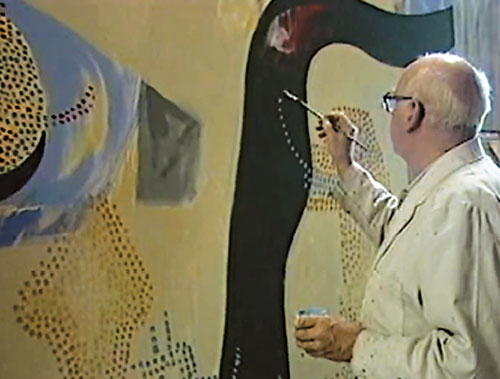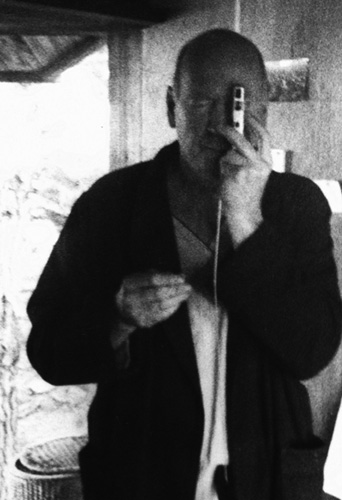Jack Wright (1919–2003)

John “Jack” Cushing Wright’s career as an artist mirrors the growth of American culture that came to prominence after World War II. Born in St. Paul, Minnesota, in 1919, he showed the inclination to be a painter at an early age. This was galvanized when he studied with the painter Cameron Booth at the St. Paul School of Art in the late 1930s.
Booth introduced him to modernism and the work of Giorgio de Chirico, Eugene Berman, Pablo Picasso, Paul Klee, and Henri Matisse. Booth’s combination of art historical instruction and personal guidance helped pave the way to Wright’s artistic devotion and open-minded ideas based on personal liberty and individual expression. He saw the possibilities that being an artist could offer him and experienced the freedom that comes with independent forethought. These early years expanded his horizons and set a lofty standard for his own artistic pursuits.
Wright joined the Army in 1942, and in 1945 he married the painter and ceramicist Patty Ordway, a partnership that would endure the rest of their lives. The Wrights moved their young family to Northern California in 1950 seeking the open-minded ideals that epitomized the Bay Area and which better mirrored their own. They settled in Marin County and Jack worked as an architectural color consultant, while still actively painting. In time the family grew to four sons. In this period he was also making inroads into the art world, having regular shows and exhibitions at such venues as The Walker Art Center and Minneapolis Institute of Art. Then in 1948 his work was shown at the Betty Parsons Gallery in New York, one of the leading avant-garde galleries of its day.

A pivotal moment in Wright’s growth came in the mid-1950s when he met the English painter Gordon Onslow Ford. Onslow Ford had been one of the original members of the Parisian Surrealists. Through Onslow Ford, Wright was also introduced to a group of painters and sculptors with whom he would go on to collaborate with for decades to come. John Anderson, J.B. Blunk, Richard Bowman, Fritz Rauh, and Lee Mullican, along with Onslow Ford, would form a veritable “lost school” of California artists. The shared vision and collaborative efforts of these artists led to a group that painted without boundaries and limitations. As a result they accomplished some of the most thorough visual research on consciousness from the perspective of visual artists done in the last century. It is only now that the public at large is being exposed to their conclusions. They behaved as pioneers forging a new direction, unrestricted by the need to make gallery-friendly art. This created a culture of creative freedom; this group that existed on the pristine ridges and mountainsides of Marin County worked far away from the commercial demands of the art world and its accompanying anxious quest for fame.
Jack’s dot-filled canvasses emphasize subtle shifting colors and evoke thoughts of ethereal grandeur that although mysterious, are also familiar and beckon us to inhabit them. The artist controls the wandering of our eye with patterned brushstrokes that keep our attention drifting along the surface of the canvas. His paintings often have a geometric base that creates a visual platform for us to stand upon as we engage his shifting luminescent world. In other places the dots drift together to form energetic masses that manifest thoughts of the cosmos and phantasmal apparitions.
Now that the dust has settled on the 20th century we have the chance to look in hindsight at the contributions of artists from the last hundred years. It is easy to focus exclusively on the work of the titans of 20th-century art. However, to do so would lead to an incomplete understanding of the century itself. By reviewing the personal revelations of artists like Jack Wright, we shed light on the great leaps forward that often occur in quiet places, and advances that fill in the gaps of history and give us the privilege of seeing a larger whole. Through the generous efforts of the Wright family and The Lucid Art Foundation, we have been given the chance to see the verses Jack Wright has contributed to this larger whole, and at the same time he has given us the honor of adding his luminous visions to our own.
– Travis Wilson